9-й Международный симпозиум по электромагнитной совместимости и электромагнитной экологии
Подождите немного. Документ загружается.


391
НЕКОТОРЫЕ СВОЙСТВА ПРОСТРАНСТВЕННОГО РАСПРЕДЕЛЕНИЯ
ИЗЛУЧЕНИЯ ВИДЕОИМПУЛЬСОВ В ДАЛЬНЕЙ ЗОНЕ
В.
Е.
О
СТАШЕВ
,
Р
ОССИЯ
,
А.
В.
У
ЛЬЯНОВ
,
Р
ОССИЯ
Объединенный институт высоких температур РАН, e-mail: ostashev@ihed.ras.ru
Аннотация. Предметом исследования является пространственное распределение плотности энергии
сверхкоротких импульсов излучения, создаваемых антенной апертурного типа. Обсуждаемой теме
посвящено много работ. Однако в них не отражена количественная связь энергетического КНД (D) и
угла расходимости излучения (
ϕ
05
), нет данных об эффективности лепестка ДНА и зависимости этого
параметра от временной формы импульса возбуждения антенны. В докладе дана оценка значений
соотношения D(
ϕ
05
)
2
/4
π
, энергетической эффективности лепестка ДНА, зависимости этих
параметров от формы импульса возбуждения раскрыва. Результаты получены моделированием
излучения круглого несинхронного раскрыва, представленного совокупностью элементарных
излучателей Гюйгенса. Построенная модель излучателя исследована на линейность и
верифицирована на сигналах типа радиоимпульс. Полученные результаты имеют практическое
значение в задачах, связанных с использованием импульсов СКИ излучения.
Abstract. The subject of this research is a spatial distribution of density of energy of UWB radiation,
created by antenna of aperture type. This subject was denoted in many articles. However in these articles
quantitative relation between the coefficient D of the directed action of antenna and the angle
ϕ
05
of
radiation disperse was not reflected. No data about the efficiency of the petal of the diagram of directivities
of antenna α(
ϕ
05
) and dependencies of these parameters from the time shape of the pulse for antenna
excitation. The estimation of values of the correlation D(
ϕ
05
)
2
/4
π
, energy efficiency of the petal of the
diagram of directivities of antenna α(
ϕ
05
), dependencies of these parameters from time shape of the pulse for
antenna excitation is made and given in this article. The results are received by method of simulation of the
radiation of round non synchronized surface of antenna, presented by collection of elementary unidirectional
radiators. The model of radiator was explored on linearity and verified on signals of the harmonic type. The
got results have practical meaning at problem, in accordance with the generation and the use of UWB
electromagnetic radiation.
Введение
Известно, что частотный спектр импульса тем
шире, чем короче этот импульс во времени (∆
ωτ
~1)
[1]. Известно также, что угловая расходимость
потока излучения
ϕ
05
направленной антенны тем
меньше, чем больше величина произведения
ω
S
,
где S – площадь апертуры антенны [2]. Из этого с
необходимостью следует, что СКИ излучатель не
является эффективной системой формирования
направленного потока излучения.
Для иллюстрации этого утверждения «в цифре»
рассмотрим простейшую модель плоского
излучающего однонаправленного несинхронного
раскрыва. Попутно отметим, что направленные
свойства антенн при излучении негармонических
сигналов обсуждались во многих работах [3-10].
Модель излучения плоского раскрыва
Пусть плоский круглый раскрыв заданного
диаметра возбуждается симметрично из точки,
удаленной на некоторое расстояние (R
ex
). Представим
раскрыв совокупностью однонаправленных
излучающих элементов Гюйгенса, ось которых
проходит через точку возбуждения раскрыва. Будем
полагать, что энергия возбуждения доставляется к
поверхности раскрыва без потерь. Поле в волновой
зоне формируется суперпозицией излучения
элементов Гюйгенса с учетом расстояния до этих
элементов, углового положения точки наблюдения по
отношению к ним, времени прихода волнового
фронта от элементов Гюйгенса, а также временной
задержки их возбуждения из-за несинхронности
возбуждения раскрыва.
Модель инвариантна по отношению к
перестановке R
ex
R, где R – расстояние от точки
наблюдения до центра раскрыва, причем для любого
угла
ϕ
отклонения этой точки от оси излучателя.
Выходными данными модели являются
напряженность поля излучения E(t,R,
ϕ
),
эффективная импульсная мощность и энергия
излучения, энергетический КНД (D = 4
π
R
2
ε
(0)/Q
изл
),
диаграмма направленности антенны (ДНА)
F(
ϕ
) =
ε
(
ϕ
)/
ε
(0) (
ε
– плотность энергии импульса
излучения), угловая расходимость излучения
ϕ
05
по
уровню 0.5
ε
(0) и энергетическая эффективность
лепестка игольчатой ДНА (энергия излучения в
пределах угла
ϕ
05
)
∫
=
2/05
0
05
sin)(
2
)(
ϕ
ϕϕϕϕα
dF
D
.
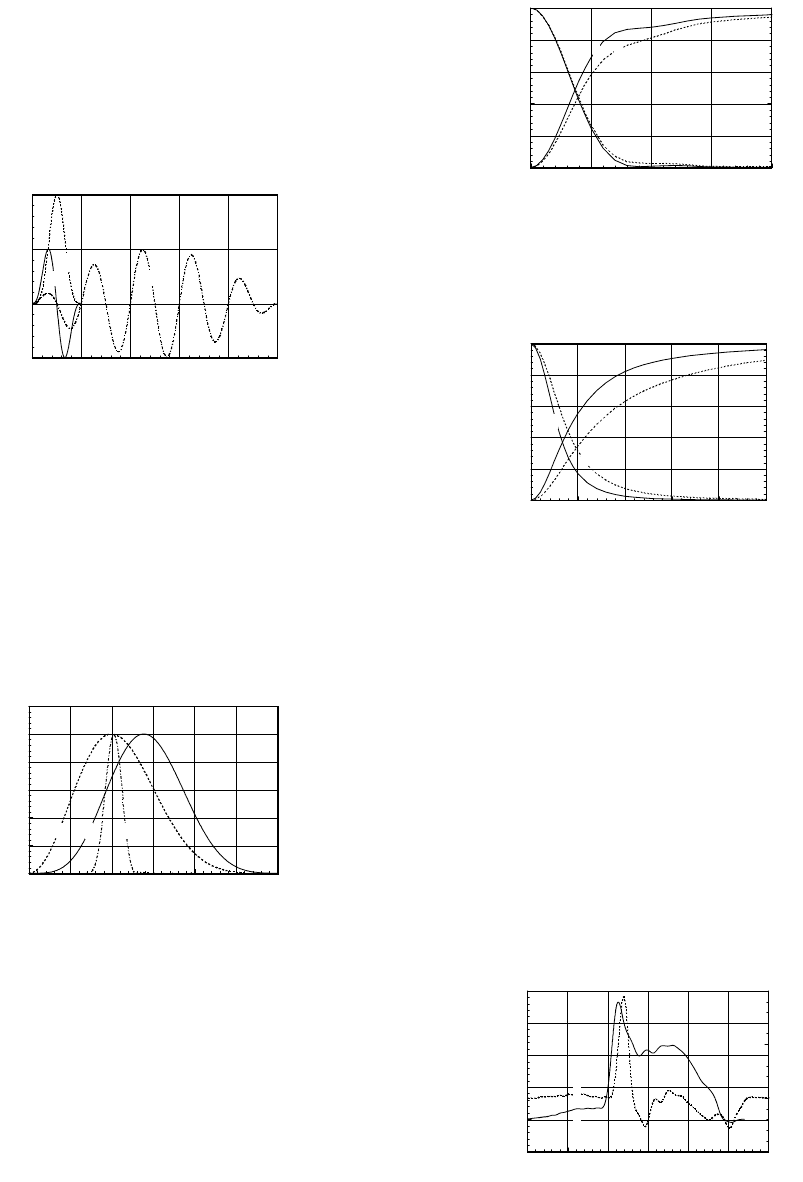
392
Вычисляется также значение соотношения
D(
ϕ
05
)
2
/4π
и спектральное распределение плотности
энергии излучения. Отметим, что при излучении
гармонических сигналов однородно возбуждаемой
апертурой D(
ϕ
05
)
2
=
4
π
.
В качестве функции возбуждения раскрыва
последовательно рассмотрим импульс, подобный
короткому радиоимпульсу, а также уни- и
биполярный импульсы (рис.
1). Уравняем полную
длительность уни- и биполярных импульсов с
периодом колебания радиоимпульса (T
=
0.5
нс).
Отметим, что максимальные значения крутизны
перепадов для этих импульсов примерно равны.
0 0,5 1 1,5 2 2,5
Время, нс
-0,5
0
0,5
1
А
м
п
л
и
т
у
д
а
1
2
3
Рис. 1. Импульсы возбуждения раскрыва:
1 – биполярный; 2 – униполярный; 3 – радио.
Выберем диаметр апертуры из условия
d
=
4cT
=
0.6
м. При этом, для выбранных импульсов
возбуждения, в пространство излучается более 85%
их энергии. Выберем координату точки возбуждения
R
ex
=
1.4
м. При этом угол обзора апертуры
составляет примерно 24
0
(характерный угол
раскрыва антенн типа ТЕМ рупора 20…30
0
).
Результаты моделирования
Структура энергетических спектров излучения
по оси антенны для заданных импульсов
возбуждения представлена на рис.
2.
0 1 2 3 4 5 6
Частота, ГГц
С
п
е
к
т
р
п
л
о
т
н
о
с
т
ь
,
о
т
н
.
е
д
.
1
2 3
Рис. 2. Структура спектра импульсов излучения
при возбуждении униполярном (1), биполярном (2) и
коротким радиоимпульсом (3).
Полуширина спектра СКИ импульсов излучения
примерно равна 2.2
ГГц, а радиоимпульса – 0.5
ГГц.
Спектр биполярного импульса смещен в
высокочастотную область. Спектр радиоимпульса
является широкополосным (∆f
/f
λ
≈
0.2).
Короткий радиоимпульс рассмотрим в качестве
асимптотического решения. На рис.
3 представлена
соответствующая ДНА F(
ϕ
) и значения доли энергии
излучения
α
(
ϕ
), заключенной внутри угла обзора
ϕ
.
При несинхронном (синхронном) возбуждении
параметры направленности плоского раскрыва
характеризуются следующими значениями:
ϕ
05
≈
14.6
0
(14.4), D
≈
136 (164),
α
(
ϕ
05
)
≈40%(47),
D(
ϕ
05
)
2
/4π
≈
0.7 (0.83). Последний параметр отличен
от единицы вследствие относительно широкого
спектра излучения.
0 10 20 30 40
ϕ
, град
0
0,2
0,4
0,6
0,8
1
F
(
ϕ
)
0
20
40
60
80
100
α
(
ϕ
)
,
%
1
2
Рис. 3. ДНА и доля полной энергии излучения при
синхронном (1) и несинхронном (2) возбуждении
апертуры радиоимпульсом.
На рис.
4 представлены те же данные при
несинхронном возбуждении раскрыва биполярным
(1) и униполярным (2) импульсами.
0 10 20 30 40 50
ϕ
, град
0
0,2
0,4
0,6
0,8
1
F
(
ϕ
)
0
20
40
60
80
100
α
(
ϕ
)
,
%
2
1
Рис. 4. ДНА и доля полной энергии излучения для
биполярного (1) и униполярного (2) импульса.
В этом случае параметры направленности
плоского раскрыва характеризуются значениями:
ϕ
05
≈
10.8
0
(14), D
≈
175 (84),
α
(
ϕ
05
)
≈28%(22),
D(
ϕ
05
)
2
/4π
≈
0.5 (0.4). Как было показано,
эффективность лепестка ДНА при возбуждении
раскрыва радиоимпульсом в 1.5 (2) раза больше.
Необходимо отметить, что при выбранных
параметрах несинхронного раскрыва характеристики
его направленности слабо зависят от форм-фактора
униполярного импульса возбуждения (смещения точки
максимума амплитуды импульса в пределах
фиксированной его длительности [11]). Если же
возбуждение раскрыва синхронное, то эта зависимость
сильная. В этом случае, при увеличении форм-фактора
импульса эффективность лепестка ДНА уменьшается.
Рассмотрим для примера характерный импульс
ГИН разработки НПАО «ФИД-Технология» [12,
13]
(рис.
5).
0 0,5 1 1,5 2 2,5 3
Время, нс
-1
0
1
2
3
4
Н
а
п
р
я
ж
е
н
и
е
,
о
т
н
.
е
д
.
-1
0
1
2
Е
п
о
л
я
и
з
л
у
ч
е
н
и
я
,
о
т
н
.
е
д
.
1
2
Рис. 5. Импульсы возбуждения антенны (1) и
излучения в волновой зоне (2).
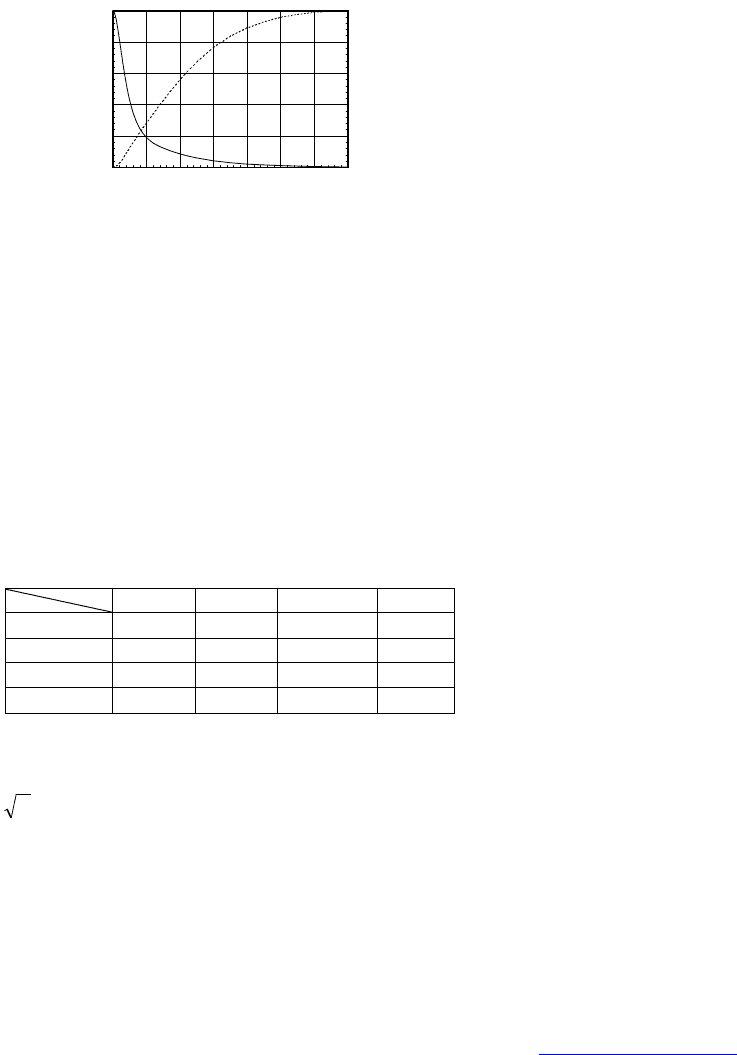
393
Фронт представленного импульса ГИН
составляет примерно 100
пс. Длительность импульса
по основанию без учета предимпульса – примерно
1.5
нс. Здесь же приведен импульс излучения (2)
несинхронного раскрыва, возбуждаемого импульсом
ГИН.
На рис.
6 представлена ДНА раскрыва и доля
энергии излучения внутри угла обзора
ϕ
.
0 20 40 60 80 100 120 140
ϕ
, град
0
0,2
0,4
0,6
0,8
1
F
(
ϕ
)
0
20
40
60
80
100
α
(
ϕ
)
,
%
Рис. 6. ДНА и доля полной энергии излучения для
импульса возбуждения на рис. 5.
Отметим прежде всего, что вследствие
рассогласования длительности импульса
возбуждения и апертурного времени d/c
=2
нс,
раскрыв излучил только 43% энергии его
возбуждения. В этом примере параметры
направленности плоского раскрыва характеризуются
следующими значениями:
ϕ
05
≈
17
0
, D
≈
26,
α
(
ϕ
05
)
≈10%, D(
ϕ
05
)
2
/4π
≈
0.18.
Выводы
В таблице представлены итоговые результаты
моделирования направленных свойств излучения
плоского несинхронного раскрыва при возбуждении
его негармоническими сигналами заданной формы.
Таблица – Итоговые результаты моделирования
Радио Бипол Унипол Реал
ϕ
05
, град
14.6 10.8 14.2 17
D 136 175 82.4 26
α
(
ϕ
05
), %
40.2 28 22.5 10
D(
ϕ
05
)
2
/4π
0.7 0.5 0.4 0.18
Результаты показывают, что СКИ излучатель не
является эффективной системой формирования
направленного потока излучения. За счет фактора
)/(
τ
cS
излучение
может
быть
сосредоточено
внутри
малого
угла
ϕ
05
,
однако
энергетическая
эффективность
лепестка
ДНА
α
(
ϕ
05
)
значительно
меньше
,
чем
при
излучении
радиоимпульса
той
же
антенной
.
Для
формирования
направленного
излучения
биполярный
СКИ
сигнал
возбуждения
предпочтительнее
,
чем
униполярный
.
При
униполярном
возбуждении
эффективность
лепестка
ДНА
тем
больше
,
чем
меньше
форм
-
фактор
сигнала
возбуждения
.
В
заключение
авторы
выражают
свою
признательность
В
.
М
.
Федорову
за
полезные
обсуждения
результатов
работы
и
критические
замечания
.
Литература
1.
Несинусоидальные
волны
в
радиолокации
и
связи
/
Х
.
Ф
.
Хармут
. –
М
.: «
Радио
и
связь
», 1985. –
376
с
.
2.
Антенны
/
Г
.
Т
.
Марков
,
Д
.
М
.
Сазонов
. –
М
.:
«
Энергия
», 1975. – 528
с
.
3.
Зернов
Н
.
В
.
Коэффициент
направленного
действия
и
эффективная
площадь
апертурной
антенны
при
излучении
и
приеме
негармонических
сигналов
//
Радиотехника
. 1995.
№
3.
С
. 51.
4.
Содин
Л
.
Г
.
Импульсное
излучение
антенны
//
Радиотехника
и
электроника
. 1998.
Том
43.
№
2.
С
. 166.
5.
Авдеев
В
.
Б
.
Экстремальные
энергетические
коэффициенты
направленного
действия
сверхширокополосной
апертурной
антенны
и
условия
их
достижения
//
Радиотехника
. 1999.
№
6.
С
. 96.
6.
Авдеев
В
.
Б
.
Энергетические
характеристики
направленности
антенн
и
антенных
систем
при
излучении
и
приеме
сверхширокополосных
сигналов
и
сверхкоротких
импульсов
//
Антенны
. 2002.
№
7(62).
С
. 5.
7.
Курочкин
А
.
П
.,
Лось
В
.
А
.,
Стрижков
В
.
А
.
Формирование
энергетических
диаграмм
направленности
видеоимпульсными
сканирующими
антенными
решетками
//
Антенны
. 2007.
№
1(116).
С
. 48.
8.
Костиков
Г
.
А
.,
Одинцов
А
.
Ю
.,
Сугак
М
.
И
.
Энергетический
коэффициент
направленного
действия
линейной
антенны
,
возбуждаемой
униполярным
или
биполярным
сверхкороткими
импульсами
//
Антенны
. 2007.
№
6(121).
С
. 46.
9.
Лаговский
Б
.
А
.
Излучение
сверхкоротких
импульсов
антенными
решетками
с
учетом
взаимовлияния
элементов
//
Антенны
.
№
9 (148).
2009.
С
. 29.
10.
Покровский
А
.
А
.,
Сугак
М
.
И
.
Энергетические
характеристики
направленности
линейной
синхронной
антенны
,
возбуждаемой
сверхкоротким
импульсом
с
несимметричными
экспоненциальными
фронтами
//
Антенны
.
№
9 (148). 2009.
С
. 37.
11.
Осташев
В
.
Е
.,
Ульянов
А
.
В
.,
Федоров
В
.
М
.
Энергетические
и
частотные
характеристики
видеоимпульсных
излучений
//
Сб
.
докл
. 9-
й
Рос
.
НТК
по
ЭМС
технич
.
средств
и
электромагнитной
безопасности
.
Санкт
-
Петербург
, 20-22
сентября
2006. –
СПб
.:
ВИТУ
, 2006.
С
. 341.
12.
Efanov V.M., Yarin P.M., Kricklenko A.V. New
Generation of High Voltage Picosecond Generators
Based on FID Technology // Proc. of the IEEE AP-S
Intern. Symp. on UNSC/URSI and AMEREM Meetings.
– Albuquerque, NM USA, July 2006. P. 72.
13.
http://fidtechnology.com

394
ULTRA-WIDEBAND TEM-HORN AND HIGH POWER RADIATORS
V.
M.
F
EDOROV
,
R
USSIA
,
E.
F.
L
EBEDEV
,
R
USSIA
,
V.
E.
O
STASHEV
,
R
USSIA
,
V.
P.
T
ARAKANOV
,
R
USSIA
,
A.
V.
U
L
’
YANOV
,
R
USSIA
Institute for High Energy Densities of AIHT of RAS, vmfedorov@ihed.ras.ru
Abstract. Results of creation and diagnostics of the high power radiators for electromagnetic waves of sub-
nanosecond pulses with ultra-wideband (UWB) frequency spectrum are presented in this article. The spec-
trum of the electromagnetic high power radiation occupies a frequency range out of 100 MHz up to 10 GHz.
This electromagnetic high power radiation can be successfully used to examine on electromagnetic compati-
bility of various electronic devices. One module of the multi-unit radiator was made of the UWB radiation
antenna of a TEM-horn type and the high power semiconductor generator (“FID Technology”) with about
10 kV pulsed voltage of the rise time of less 100ps and repetition pulses up to 100 kHz as well as synchro-
nizing unit. We have used experimental and computer modeling methods to investigate the non-stationary
processes in a generation of the UWB radiation by the TEM-horn antennas and at propagation and receiving
of the electromagnetic video-pulses.
Introduction
The high power semiconductor generators with re-
peated sub-nanosecond pulses are developed last years
and successfully used [1-4]. They are applied as a power
source for a radiation of electromagnetic sub-nanosecond
video-pulsed with ultra-wideband frequency spectrum
(UWB radiation). The giga-watt-range power UWB ra-
diators with controlled parameters can be constructed as
multi-source system using the UWB radiators with semi-
conductor generators [3, 4]. At this way few problems
are arisen like electromagnetic compatibility of the high
power sources with the triggering and control systems
(low voltage pulses), realization of low jitter of delay
time between the UWB radiators, compatibility of high
voltage insulation and wideband frequency in the an-
tenna unit. The electromagnetic high power radiation in
the frequency range of 100 MHz - 10 GHz is possible
realized with using TEM-horn antennas and the high
power generators with pulsed voltage of the rise time of
50ps. Analyses of results on creation and diagnostics of
the high power radiators for video-pulses of sub-
nanosecond duration will be presented in this article.
Ultra fast measuring devices
The measurements of sub-nanosecond electrical
pulses from electromagnetic sensors with short cables
and to place at not large distance from the high power
radiators are produced using two devices. First of all we
use the TMR18 [5] – digital sampling registrar for elec-
trical signals with DC-18 GHz bandwidth. It was placed
into metallic full electrical shielding box. The registrar
was controlled by removed computer with optical net-
work cable. In the second, we use digital sampling ana-
lyzer of the DSA8200 (Tektronix) with 30 GHz band-
width. The analyzer connects with remote (2m cable) the
electrical sampling module of the 80E07. The DSA8200
main frame was placed into electrical shielding box.
Check-up of diagnostic feeders and voltage dividers was
made using the DSA8200 with remote sampling module
of the 80E08 for time-domain- reflectometry (TDR)
measurements.
Few test generators (TRIM Ltd [5]) with low volt-
age pulses were used. In particular, TMG30-35 (bell
pulse – V
TMG
=25V, T
0.5
=35ps), TMG60-50 (triangle -
54V, T
f
=57ps), TMG40-20 (rectangle – 33V, T
f
=19ps).
These generators are used at experiments to measure a
sensitivity of electromagnetic sensors and a voltage ratio
for the high voltage divider. The measurements were
provided using the attenuators (2.92mm connectors) with
40GHz bandwidth (SM Electronics Co.).
EMW sensors and reciprocity for pulsed anten-
nas
The E(t) electric field in electromagnetic traveling
wave (EMW) is measured by few sensors: the TMA18
and TMA20- test receive antennas [5] with bandwidth at
0.3-18 GHz and at 1-20 GHz; and linear strip transducer
of LTF2 (IHED RAS). Antennas of the TMA have big
effective receive aperture (cross-section of open metallic
waveguides: 28x38cm and 11x15cm). They provide high
sensitivity of V
TMA
(t)=K
TMA
*E(t): K
TMA18
≈60 V/(kV/m),
K
TMA20
≈26 V/(kV/m). They allow to measure waves of
the pulse radiation on distances more 10m when we use
the low voltage generators to excite antennas. Some de-
fect of the TMA receive antennas for the time-domain
measurement of the E(t) electric fields are non constant
of the K
TMA
value at ultra broad frequency bandwidth (to
cut down at lower frequency). At result, they produce a
distortion of the E(t) signals like distortion will be pro-
duced the “C-R” differentiating circuit. Part of test sys-
tem with the TMA18 antenna is shown in Fig.1.
The E(t) signals generating at during of a limited
time interval (e.g. UWB pulse radiation) may be meas-
ured by a linear strip sensor (ch.3 at [6]). We constructed
the LTF2 sensor of like that type with parameters: T
f
≈20ps- transient response rise time; T
max
=2.8ns- time
interval; K
LTF2
=0.4V/(kV/m)- sensitivity; 0.5m- cable
length to connect. Low sensitivity of the sensor is due to
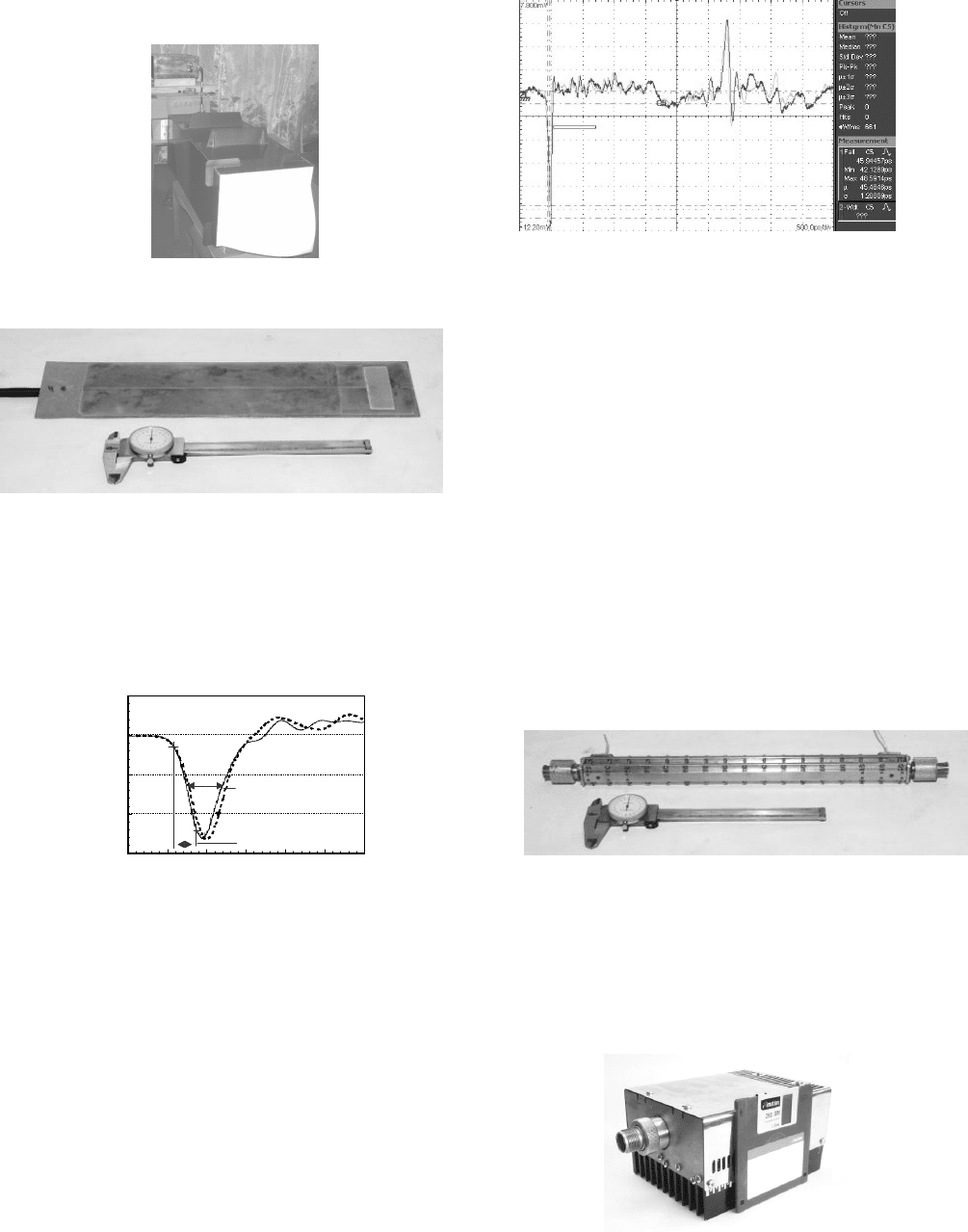
395
small receiving effective aperture (≈1mm
2
). View of
LTF2 is presented on Fig.2.
Fig.1. Measure arrangement with digital analyzer of
TMR18 connected by short cable with receive
antenna of TMA18.
Fig.2. Linear strip transducer of LTF2 for measurement
of the E(t) pulse electric field in TEM traveling wave.
A measurement of the LTF2 characteristics was
made using own made two-electrode TEM-horn. The
horn was excited by the TMG test generators. Finally,
the E(t) =V(t)
TMG
/h - electric field in electromagnetic
traveling wave into a gap of the h was generated. Shapes
of signals of E(t)and V(t)
TMG
are shown on Fig.3.
0 0,05 0,1 0,15 0,2 0,25 0,3
time, ns
-0,3
-0,2
-0,1
0
0,1
S
i
g
n
a
l
s
,
V
44пс
30ps
0.1
0.9
44ps
Fig.3. Shape of the V(t)
TMG
– TMG30-35 (smoothed) and
a voltage signal from the LTF2 sensor (dotted)
Very useful attribute of a system for electromagnetic
waves with the receiving antenna and the radiating an-
tenna is so-called the reciprocity of they (for voltage
linear systems). It means the received signals will be
identically when we change places of the receiving and
radiating antennas. The reciprocity principle for antennas
in a case of harmonic oscillations is good known and
widely used. In a case of pulsed signals (e.g. UWB pulse
radiation) the reciprocity principle is opposite low used.
Note, theory of the reciprocity theorem for electrody-
namics of non-stationary process was published long ago
[7]. We did experiments using the LTF2 sensor and the
FN5 antenna (such as FN3 in the 5-th section) and this
result is given on Fig.4.
Fig.4. Two traces on screen of DSA8200 for the receiv-
ing signals of the E(t) pulse radiation. Black trace is next
scene: TMG40+FN5(radiator) - 4m distance –
LTF2(receiver). Gray trace: TMG40+LTF2(radiator) -
4m distance – FN5(receiver).
One can see the two traces are practically identical. Plus
polarity peak in two signals was generated by reflection
on the LTF2 strip line end. The test result on Fig.4 has
shown success application of the principle of reciprocity
for the receiving and radiating antennas in a case of elec-
tromagnetic pulsed signals. Note, it is not recognized
theorem. For instance, authors of book (ch. 1, 5 at [6])
confirm that antenna of strip line type (note, like the
LTF2 sensor) is good receiving pulsed EM-fields while
this antenna will not radiate the pulsed EM-fields. It is
result of used approximate theory of two-wire line.
High voltage divider for picoseconds pulses
High voltage divider of the DCF3 was constructed
on base of high voltage coaxial line (9mm polythene
50Ω cable) with direct coupler. DCF3 was supplied two
connectors (on input and output) of HN male type which
has pulse electrical strength more 20 kV (see on Fig.5).
Fig.5. High voltage divider of DCF3: HN male-
input (output) connector, T
f
≈20ps- self rise time, T
max
=2.8ns- time duration, K
DCF
≈70:1- ratio voltage, 0.7m
cable length to connect with oscilloscope
The DCF3 was used in measurements of high volt-
age sub-nanosecond pulse from generators of GIN10-50-
100. In these experiments we used additionally the at-
tenuators with 50dB total weakening. View of GIN10-
50-100 [2] is presented on Fig.6
Fig.6. Gin10-50-100 generated pulses of about 10 kV
(with rise time of 50-70 ps) with repetition pulses up to
100 kHz. Output feeder is HN-female connector.
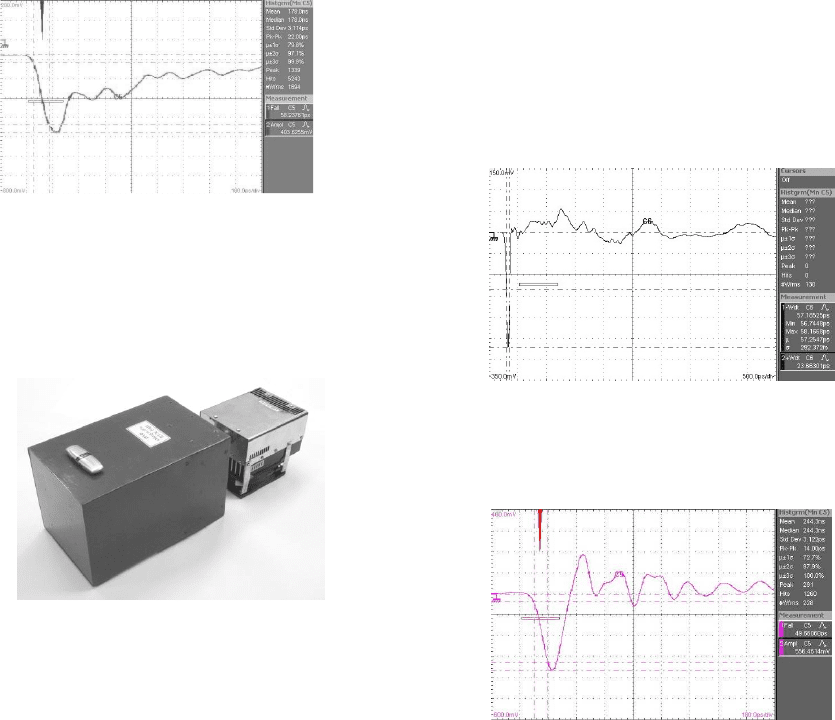
396
In our experiments we use also Gin10N-50-100 modifi-
cation [2] with output feeder of N-female connector to
realize faster rise time of pulse voltage.
Verification of HN-connector we performed using two
adapters of HN-N +N-HN to transport step pulse with T
f
≈20ps rise time (80E08 module). The result was follow-
ing: HN-connector is came in useful to transport pulse
with T
f
≥20ps, parasite oscillations has less 10%.
V
GIN
(t) of GIN10-50-100 is shown on Fig.7.
Fig.7. Display picture with voltage of V
pG
(t)- rapid leap
for GIN10-50-100: V
pG
= 8.8kV- peak, T
f
=58ps
(0.1-0.9 levels), V
G
= 10.5kV total amplitude
(with pedestal). Low jitter of 3.1ps was registered.
High power impulse radiation of pico-second range
We have created new the 50ps antenna units
FN3&5 for high power “fast radiators”(Fig.8).
Fig.8. Fast radiator on base of the FN3 antenna con-
nected with GIN10-50-100 (see Figs.6-7).
The FN3&5 radiation antenna has aperture size of
the 16×16 cm
2
, it is built by four TEM-horns with di-
electric insertions for best phasing of waves at radiating
aperture. FN3 is supplied input high voltage connector of
the HN male type, FN5 with N-connector (10kV strength
for sub-nanosecond pulses).
Voltage in the receiving antenna can find by using
power balance equation and antenna transient response:
E
2
·A
ef
/W
o
=V
2
/W
A
; V
A
(t)=(A
ef
·W
A
/W
0
)
0.5
·∫F
A
(t-τ)E(τ)dτ (1)
where are: V
A
(t) -voltage on antenna feeder; A
ef
–
receiving effective aperture square; E(t) –electric field of
incident wave on aperture; W
0
=120π Ω; W
A
=50 Ω;
F
A
(t)– function of pulsed transient response for the re-
ceiving antenna. Simple approximation is
F
A
(t)= d((1-e
-t/τ1
)·e
-t/τ2
)/dt, where: τ1=τ
u
=τ
f
/2.3, τ2=τ
d
(2)
τ
f
- rise time; τ2 = τ
d
– decay time.
E
R
(t) field is radiated by TEM-horn antenna excited
by V
GIN
(t) we calculate by computer simulation of nu-
merical 3D full-electromagnetic PIC code KARAT [8],
and by known approximate Huygens- Kirchhoff method
or method of secondary radiators [9]. Extended in time-
domain application is
V
ER
(t) = E
R
(t, R)·R=(1/2π·c)d(∫E
A
(t,r)dA)/dt (3)
V
ER
(t) = ξ
0
(A
ef
η)
0.5
d(∫F
A
(t-τ)·V
GIN
(τ)dτ/c)/dt (4)
where are: V
ER
=E
R
(t, R)·R–radiated voltage; R –distance;
ξ
0
= (0.6/π)
0.5
; c – light velocity; V
GIN
(t) – supply voltage;
η-efficiency; F
A
(t)–pulsed transient function from Eq.(1)
because it is equal for receiver and radiator modes as the
reciprocity principle dictates.
Time response of the E
R
(t) in EM-wave is radiated
the FN5 excited by the TMG40-step generator was pre-
sented on Fig.4 and it is correct for limited time interval
of 2.8ns. We used two TEM antennas of FN5- one is a
radiator and other is receiver to get more time duration
for the E
R
(t) (see on Fig.9).
Fig.9. E(t)-pulse radiation for scene: TMG40 +
FN5(radiator) – 3.6m distance – FN5(receiver)+10dB.
Fast generator of the GIN10-50-100 (pulse charac-
teristics on Fig.7) was loaded on the FN3 (Fig.8). Pulse
radiation signal is sown in Fig.10.
Fig.10. E(t)-pulse radiation from FN3+GIN10-50-100, it
was received by LTF2 sensor at R=6.4m distance. First
oscillation has rise time of τ
f
= 45ps and T
0.5
=70ps.
In these experiments we used 10dB attenuator to connect
LTF2 sensor with the 80E07 remote module of
DSA8200. Radiated peak voltage for fast radiator (Fig.9)
was produced V
ER
=E
max
R =21kV, normalized radiated
voltage equals V
ER
/ V
pG
=2.4.
Measured signals of the E(t) on Figs.4, 9 were used
to calculate the values for the FN5 antenna of τ
uFN5
=16ps, and τ
dFN5
= 2.3ns and A
ef
=185cm
2
. These con-
stant time for Eq.2 we can use to calculate down and
upper frequencies of f
d
=1/(2π τ
dFN5
) ≈70kHz and f
u
=1/(2π τ
uFN5
) ≈10GHz for the FN5 antenna. These re-
sults show possibility to use TEM-horn antenna of the
FN5 to produce UWB pulse radiation in range from
UNF up to microwaves.
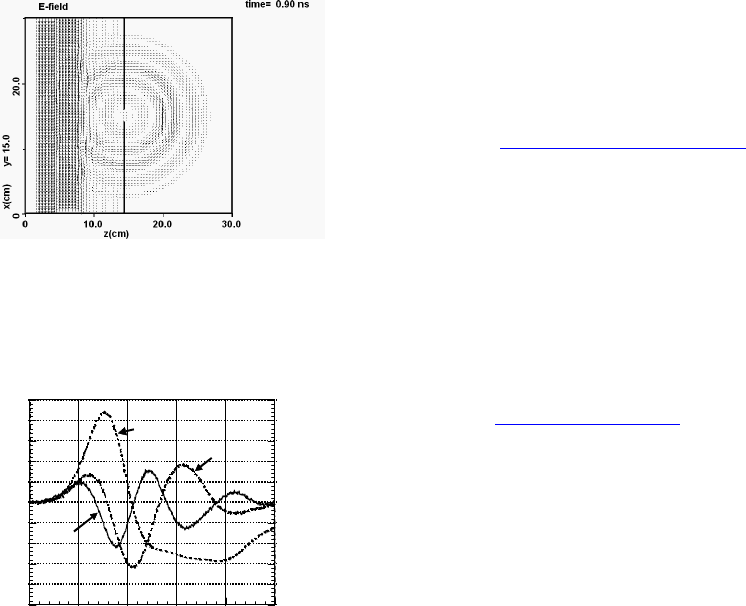
397
Note, the τ
d
– decay time in approximate Eq. (2) ap-
plied to the TEM-horn antennas is limited longitudinal
size rather than size of the aperture. This is confirming
results on Fig.4 (the LTF2 with small aperture has radi-
ated in ultra band frequencies like the FN5 with “big”
aperture). Of course, antenna with small aperture would
radiate only small part of incident electric power on the
aperture. Authors of book (ch. 17 in [10]) confirm mis-
takenly that poor power efficiency of radiated antenna is
predicted bad transient response of this antenna.
Non –stationary processes at propagation of the
electromagnetic video-pulses
Very interesting phenomenon happens when elec-
tromagnetic wave of the video-pulse comes to metallic
plate with small hole. This plate with hole plays the role
of the open resonator which is excited by the UWB pulse
like shock pulse. One picture of computer simulation by
code of KARAT is shown in Fig.10.
Fig.10. Picture of electric vectors for t = 0.9ns from be-
ginning process. The TEM plane wave (vertical polariza-
tion) of the video-pulse (single period of the sine by
length ∆
z
=6cm ) comes from left boundary. Metallic
plate (z = 15cm) has hole with 2cm diameter
Experimental results are presented on Fig.11.
0 0,1 0,2 0,3 0,4 0,5
Time, ns
-1
-0,8
-0,6
-0,4
-0,2
0
0,2
0,4
0,6
0,8
1
S
i
g
n
a
l
s
,
V
1
3
2
Fig.11. Wave form for the E(t) of the UWB fast pulse
radiation beyond a screen with a hole (diameter of 3cm
and 1,5cm). “1” – without screen, it uses K
1
=1- signal
gain factor. “2” – with 3cm hole in metallic screen,
K
2
=20- signal gain factor. “3” – with 1.5cm hole,
K
3
=80- signal gain factor.
These experiments on diffraction of the UWB fast pulse
radiation on hole for D
2
=3cm and D
3
=1.5cm diameters
in metallic screen were provided in following conditions.
AntFN3 is excited by TMG60. Metallic plane screen
with hole is placed at 16cm distance before AntFN3 ap-
erture. Distance between AntFN3 and the TMA18 re-
ceive antenna is 3.3m. Electrical signal is measured by
TMR18 (Fig.1). Signals on Fig.11 are normalized, that
weak signal is gained.
Given results have importance at estimation shield-
ing characteristic of the screen with hole, as well as in
experiment, when is required to localize the UWB elec-
tromagnetic wave on under investigation object.
Conclusion
The radiator for high power video-pulses with rise
time of 45ps and FWHM about 70 ps was constructed
and successfully employed with the FOM up to 21kV
and repetition pulses up to 100 kHz. The non-stationary
processes are main source for singularities at diffraction
of the electromagnetic video-pulses in a hole in conduc-
tor screen.
References
1. Efanov V.M., Kricklenko A.V., Komashko
A.V., Yarin P.M. High Voltage Picosecond FID Genera-
tors
// Proc. of the IEEE AP-S Intern. Symp and UNSC/URSI
and AMEREM Meetings. – Albuquerque, NM USA,
July 2006. P. 74.
2. http://www.fidtechnology.com.
3. Fedorov V.M., Grekhov I.V., Lebedev E.F., et.
al. High Power Radiators for Electromagnetic Waves of
Video-Pulses and Singularities at Propagation of Them
// Proc. of the 7
th
Intern. Symp. On Electro-magn. Com-
patibility and Electromagnetic Ecology. St.Petersburg,
June 2007. P. 173.
4. Fedorov V.M., Lebedev E.F.,
Ostashev V.E.,
Ul’yanov A.V. Ultra-Wideband Picosecond High Power
Radiators // Proc. of the 16
th
Intern. Symp. on High Cur-
rent Electronics. Tomsk: Publishing house of the IAO
SB RAS, 2010. P. 437-440.
5. http://www.trimcom.ru.
6. S.A.Podosenov, A.A.Potapov, A.A.Sokolov.
Impulse Electrodynamics of Wideband Radio System
and Fields of Linked Structures. M.: “Radiotechnik”,
2003.-720 p. (in rus.)
7. Fel’d J.N., Sov. Dokl. Akademii Nauk USSR
41, №7, 294-297, (1943).
8. Tarakanov V.P. Universal Electromagnetic code
KARAT // In book "Mathematical Simulation. Problems
and Results" - M.: Nauka. 2003. - 408 p. (rus.)
9. J.A.Stretton. Electromagnetic Theory. N.Y.,
1941. (Rus. transl., M.: Gostechizdat. 1948. 539 p.)
10. Problems of Subsurface Radar. Editor-in-chief
by Grinev A.U. –M.: “Radiotechnik”, 2005.-416 p. (in
rus.)

398
МЕТОД ОЦЕНКИ РЕАЛИЗУЕМЫХ ПАРАМЕТРОВ ЗАДАННОЙ
ДИАГРАММЫ НАПРАВЛЕННОСТИ В ЗАДАЧАХ СИНТЕЗА АНТЕНН
Д.
Д.
Г
АБРИЭЛЬЯН
1
,
Р
ОССИЯ
,
Е.
Н.
М
ИЩЕНКО
2
,
Р
ОССИЯ
,
С.
Е.
М
ИЩЕНКО
1
,
Р
ОССИЯ
,
И.
С.
С
АВЧЕНКО
1
,
Р
ОССИЯ
1
Ростовский технологический институт сервиса и туризма,
2
Ростовский военный институт ракетных войск, e-mail: mihome@yandex.ru
Аннотация.
Получены соотношения, позволяющие выразить целевую функцию задачи синтеза ан-
тенной решетки как функцию параметров заданной диаграммы направленности. Эти соотношения
использованы для определения градиента целевой функции по искомым параметрам. В общем случае
определение оптимальных параметров заданной диаграммы направленности сводится к реализации
процедуры градиентного спуска. Для проверки соотношений рассмотрен численный пример, в кото-
ром оценивается оптимальный набор параметров косекансной диаграммы направленности дуговой
антенной решетки.
Abstract. The relations are obtained allow to express the goal function of synthesis problem of the antenna
array as a function of the pre-assigned pattern parameters. These relations are used to determine the gradient
of the goal function. In general case the determination of optimal parameters of the pre-assigned radiation
pattern is to implement procedures for gradient descent. To test the relations discussed a numerical example
in which the estimated optimal parameters of radiation pattern of the arc antenna array.
Введение
Одним из основных вопросов теории синтеза
антенн является определение условий существования
точного решения задач синтеза антенных решеток
(АР). При использовании классического подхода [1-
3] для ответа на него исходят из физических сообра-
жений: мощность, излучаемая антенной в любом
направлении, конечна. Это означает, что функция,
описывающая диаграмму направленности (ДН) ан-
тенны, является непрерывной и интегрируемой в
квадрате. Особое место в теории синтеза антенн так-
же занимает аналитическое решение задачи Дольфа-
Чебышева [3,4], которое позволяет обеспечить ми-
нимальную ширину луча ДН линейной АР при за-
данном уровне боковых лепестков или, наоборот.
Однако, данное решение в основном имеет теорети-
ческое значение и не может быть использовано для
антенн произвольной геометрии. В случае размеще-
ния АР на поверхности вращения оценка реализуе-
мых параметров ДН может быть произведена путем
сопоставления характеристик кольцевой и линейной
АР, что было показано в работе [5]. В более общем
случае АР произвольной геометрии в соответствии с
работой [6] необходимо оценивать диаметр сферы, в
которую может быть вписан раскрыв антенны, т.е.
оценка достижимых параметров ДН осуществляется
с использованием достаточно приближенного метода
эквивалентного плоского раскрыва [7]. Это означает,
что по мере усложнения геометрии АР задача оценки
реализуемых параметров ДН становится все более
сложной. Поэтому с научной и практической точек
зрения представляет интерес разработка метода ис-
следования реализуемых параметров ДН АР произ-
вольной геометрии.
В докладе представлен метод оценки реализуе-
мых параметров ДН АР произвольной геометрии на
основе известного аналитического решения задачи
амплитудно-фазового синтеза антенны.
Метод решения
Рассмотрим
N
-элементную АР, ДН которой
представляет собой суперпозицию ДН излучателей
АР:
( ) ( )
∑
=
ϕθ=ϕθ
N
n
nn
fwF
1
,,
, (1)
где
Nn ,...,2,1
=
;
n
w
− комплексная амплитуда воз-
буждения
n
-го излучателя;
(
)
uf
n
− комплексная
функция, описывающая ДН
n
-го излучателя АР.
Предположим, необходимо решить задачу син-
теза рассматриваемой АР, в результате чего будет
найдено распределение комплексных амплитуд воз-
буждения излучателей
{
}
n
w
, обеспечивающее ми-
нимальное отклонение ДН АР
(
)
uF
от заданной ДН
(
)
ϕθ,
0
F
в смысле заданного критерия:
{ }
(
)
(
)
(
)
ϕθϕθ ,,,min
0
FFQ
n
w
(2)
где
(
)
(
)
(
)
ϕθϕθ ,,,
0
FFQ
− целевая функция задачи
синтеза.
Качество решения задачи синтеза определяется
выбором заданной ДН. Если заданная ДН может
быть реализована с помощью рассматриваемой АР
абсолютно точно, то решению задачи синтеза соот-
ветствует значение целевой функции
(
)
(
)
(
)
0,,,
0
=ϕθϕθ FFQ
. Конфигурация АР, заданная
функциями
(
)
ϕθ,
n
f
, полностью определяет множе-
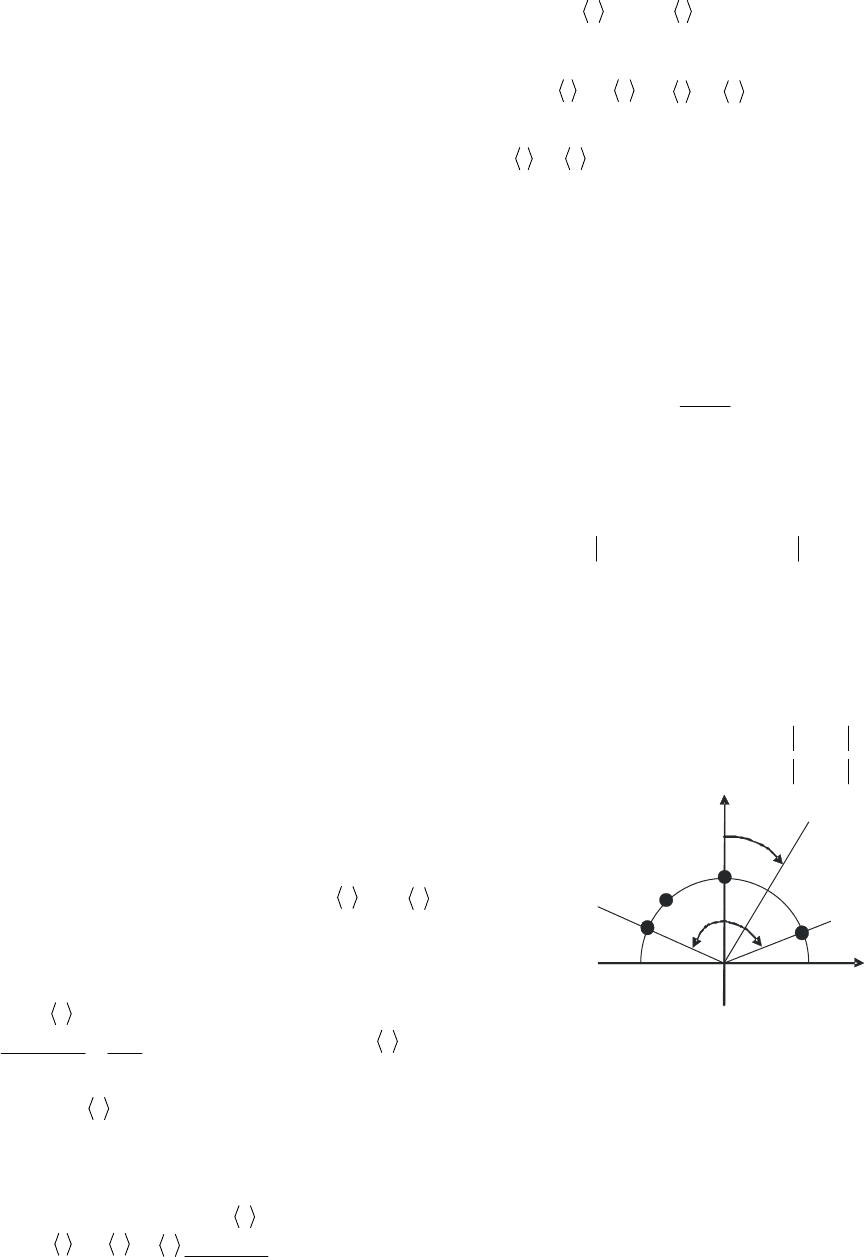
399
ство реализуемых ДН рассматриваемой АР. Если
заданную ДН представить как функцию параметров
i
p
(
,...)2,1=i
в виде
(
)
i
pF ,,
0
ϕθ
, то возникает задача
выбора параметров заданной ДН, которые для рас-
сматриваемой АР обеспечивают минимально воз-
можное значение целевой функции, т.е. задача вида:
{ } { }
( ) ( )( )
ϕθϕθ
i
wp
pFFQ
ni
,,,,minmin
0
. (3)
Для решения сформулированной задачи (3) уч-
тем, что в случае реализуемой заданной ДН значение
целевой функции обращается в ноль не зависимо от
того, какой метод используется для определения
комплексных амплитуд возбуждения коэффициентов
{
}
n
w
.
Поэтому для решения задачи синтеза (2) вос-
пользуемся методом наименьших квадратов, в соот-
ветствии с которым запишем:
( ) ( )
i
N
m
mmnin
pPpw
∑
=
η=
1
,
, (4)
где
1−
= SP
− обратная матрица квадратной матрицы
S
с коэффициентами (
Nm ,...,2,1
=
):
( ) ( )
∫ ∫
π π
π−
ϕθθϕθϕθ=
0
2/
2/
*
,
sin,, ddffS
mnnm
;; (5)
( ) ( ) ( )
∫ ∫
π π
π−
ϕθθϕθϕθ=η
0
2/
2/
*
0
sin,,, ddfpFp
miim
. (6)
С учетом выражений (1) и (4) постановка рас-
сматриваемой задачи (3) может быть переписана в
виде:
{ }
( ) ( ) ( )
ϕθηϕθ
∑ ∑
= =
i
N
n
i
N
m
mmnn
p
pFpPfQ
i
,,,,min
0
1 1
,
. (7)
Решение задачи (7) найдем методом градиент-
ного спуска. Для этого сначала зададим начальные
значения итерационного процесса:
0
i
p
и
0
λ
−
параметры заданной ДН и скорость приближения к
экстремуму соответственно. После чего найдем ком-
поненты градиента целевой функции:
( )
.,,,
,,
0
0
1
0
1
,
0
ϕθ
ηϕθ
∂
∂
=
∂
∂
∑ ∑
= =
i
N
n
i
N
m
mmnn
jj
i
pF
pPfQ
pp
pQ
.(8)
Новые значения параметров заданной ДН опре-
делим по формулам:
j
i
jj
p
pQ
pp
∂
∂
λ−=
0
0
01
. (9)
Если
<
10
ii
pQpQ
, (10)
то
01
ii
pp =
и
2/
01
λ=λ
. (11)
При нарушении неравенства (10) принимаем
01
λ=λ
.
Циклическое повторение выражений (8)-(11) по-
зволяет приблизиться к экстремуму целевой функ-
ции с любой заданной точностью [3].
Численный пример
В качестве примера рассмотрим задачу опреде-
ления реализуемых параметров косекансной ДН вида
в смысле критерия (7):
( )
( ) ( )
θ>θ∧θ<θ
θ≤θ≤θ
θ
θ
θ<θ≤θ
=θθθθ
.,
;,
sin
sin
;,1
,,,,
21
20
0
01
2100
r
rF
(12)
Пусть целевая функция задачи имеет вид:
(
)
(
)
(
)
( ) ( )
.,,,,
,,,,,
5,0
0
2
2100
2100
∫
π
θθ−θθθθ=
=θθθθθ
dFrF
rFFQ
(14)
Излучатели дуговой 32-х элементной АР разме-
щены на окружности радиуса
a
. Шаг между излуча-
телями выберем равным
λ
495,0
. ДН излучателей
решетки описываются выражениями вида:
(
)
( )
( )
>θ−θ
≤θ−θθ−θ
=
=θ
θ−θθ
,90,0
;90,cos
cossin
o
n
o
n
ika
n
n
n
e
f
(15)
где
n
θ
− координаты
n
-го излучателя,
Nn ,...,2,1
=
.
Геометрия задачи приведена на рис. 1. Начальная
скорость приближения к экстремуму для каждого
параметра при решении задачи выбиралась таким
образом, чтобы после первой итерации искомые па-
раметры сохраняли свой смысл и форма заданной
ДН не нарушалась.
В таблице 1 представлены оценки оптимальных
параметров заданной косекансной ДН, полученные
для АР, размещенных вдоль окружностей с различ-
θ
Рис. 1.
?
θ
1
+
θ
N
0
a
x
y
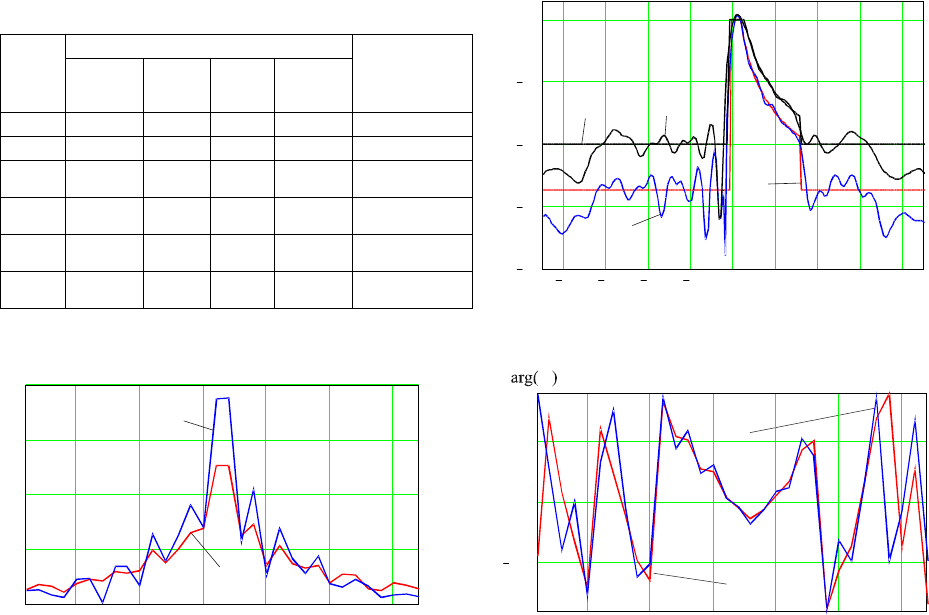
400
ными радиусами. В первой строке таблицы 1 приве-
дены начальные параметры ДН.
Анализ данных таблицы 1 позволяет сделать
вывод о том, что по мере увеличения радиуса окруж-
ности уменьшается величина отклонения между син-
тезированной и заданной ДН. При этом оценки оп-
тимальных параметров заданной ДН также ведут
себя монотонно. Это позволяет сделать вывод о том,
что предложенный метод может быть использован
для оценки потенциальных возможностей АР с за-
данной конфигурацией.
На рис. 2 в качестве примера при
λ
=
11a
пред-
ставлены заданные (кривые 1 и 2) и синтезированные
ДН (кривые 3 и 4) АР до и после выбора оптималь-
ного набора параметров соответственно.
На рис. 3 и 4 приведены распределения ампли-
туд и фаз возбуждения излучателей АР, полученные
при заданных АР с неоптимальными (кривые 1) и
оптимальными (кривые 2) параметрами.
Полученные результаты показывают, что выбор
оптимальных параметров заданной ДН позволяет
получить существенно более гладкое решение задачи
апроксимационного амплитудно-фазового синтеза, в
котором отсутствуют существенные изменения ам-
плитуд возбуждения излучателей. Для оценки всех
параметров было достаточно выполнить не более 10
итераций.
Заключение
Таким образом, предложенный метод может
быть использован для исследования потенциально
достижимых характеристик антенных решеток про-
извольной геометрии, а также для уточнения анали-
тического представления заданной ДН в задачах
синтеза антенн.
Литература
1. Минкович Б.М., Яковлев В.П. Теория синтеза
антенн. − М.: Сов. радио, 1969. 296с.
2. Дмитриев В.И., Березина Н.И. Численные ме-
тоды решения задач синтеза излучающих систем. −
М.: Изд-во МГУ, 1986. 112с.
3. Зелкин Е.Г., Соколов В.Г. Методы синтеза ан-
тенн: Фазированные антенные решетки и антенны с
непрерывным раскрывом. − М.: Сов. радио, 1980. 296с.
4. Айзенберг Г.З. и др. Антенны УКВ / Под ред.
Г.З. Айзенберга. В 2-х ч. Ч.2. − М.: Связь, 1977. − 288с.
5. Габриэльян Д.Д., Мищенко С.Е. Алгоритм
управления цилиндрической антенной решеткой при
сканировании в угломестной плоскости // Сб.
Антенны, 1997, № Вып.1(38), с. 44-46.
6. Коваленко Н.В. Обратные электродинамиче-
ские задачи для антенных решеток, расположенных
на плоских и криволинейных поверхностях. В кн.
Антенные решетки. − Ростов-на-Дону, 1971, с.48-53.
7. Воскресенский Д.И., Степаненко В.И., Фи-
липпов В.С. и др. Устройства СВЧ и антенны. Про-
ектирование фазированных антенных решеток: Учеб.
пособие для вузов / Под ред. Д.И. Воскресенского. −
М.: Радиотехника, 2003, 632с.
Таблица 1
Параметры заданной ДН
a
,
λ
1
θ
,
град.
0
θ
,
град.
2
θ
,
град.
r
Оценка
отклоне-
ния ДН
−
−2 5 31 0,1 −
9 −2,43 4,843 30,9 0,026 0,01
11 −1,56 3,432 31,1 0,043
3
10103,6
−
⋅
13 −1,838 3,262 31,1 0,034
3
10863,5
−
⋅
15 −1,734 3,202 31,1 0,034
3
10741,5
−
⋅
100 −1,222 3,116 31,1 0,046
3
10604,5
−
⋅
80
60
40
20
0
20
40
60
θ
,
град.
Рис. 2
.
40
30
20
10
0
1
4
3
2
F
(
θ
), дБ
5 10
15
20
25
N
Рис. 3.
0
0.05
0.1
0.15
0.2
|w
n
|
1
2
1
2
5
10 15 20
25
N
Рис. 4.
100
0
100
w
n
